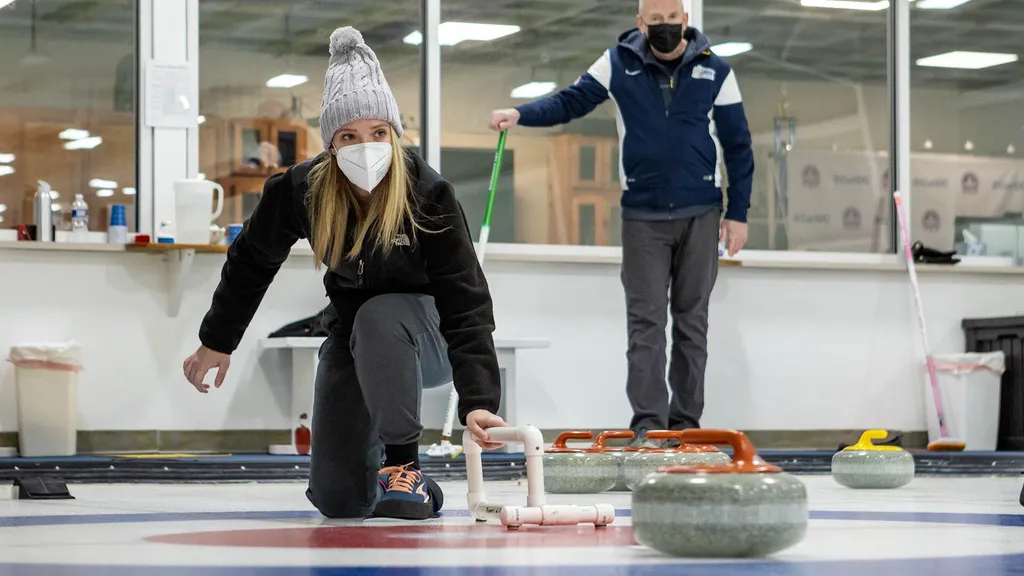- February 02, 2022
- By Annie Krakower
Crouching on the slightly textured ice at the Potomac Curling Club, I grab hold of a disk-like granite rock and glance at a giant red-and-blue target just over 40 yards away. As long as I don’t fall—definitely not guaranteed, I think to myself—surely the slick surface should allow me to easily glide the stone into an area big enough to swallow a compact car.
I shift my weight back, lunge forward, release. After a while, the stone glides forlornly to a halt several feet short of where I was aiming.
It’s my first experience with curling, the unique sport that begins in the Winter Olympics in Beijing today and that alternately captivates and confuses viewers worldwide every four years. With its uniquely placid style of play and exotic terminology and gear, the slippery pastime poses plenty of questions for the uninitiated: Why’s it even called curling? What exactly are they doing with those brooms? And who first thought, “This rock needs a handle?”
Luckily for me, on this day in late January, two expert Terps have volunteered to show me the ropes: Katherine Gourianova ’23, a member of Team USA who won the 2019 Mixed National Championship and competed on the world stage, and Eric Clawson ‘83, Team USA coach during that year’s world championship. They make the sliding and sweeping look easy, but I promise, it’s not.
“A lot of people see curling and see the target and just go, ‘Well, why don’t you just put it in the middle?’” says Gourianova, a neuroscience and linguistics double major who took up curling after years of ice skating. “It’s a lot more complicated than that.”

After giving me some rubber grips for my shoes so I don’t faceplant on the ice, the pair first shows me the delivery side of the sport—sending the rock down the ice toward the “house,” or target. The 42-pound stone’s handle allows for a bit of spin as you push off the starting block, called the hack, causing the rock to curl (aha, things are starting to make sense!) either clockwise or counterclockwise.
All of my deliveries are veering off-target, but at least it’s just practice. In actual competition, the teams both throw eight rocks and get a point for each one that’s closer to the center of the house than any of the opposition’s at the conclusion of each “end,” which is like an inning in baseball.
I’m mostly focused on keeping my balance and attempting—unsuccessfully—to get my rocks to the “hog line,” the line 21 feet from the house’s center that the stones must pass. (At Potomac Curling Club, it’s conveniently marked with colorful pig figurines.) Real curlers often seek to create a barrier of guard rocks ahead of the house, making it harder for other teams to score.
“One of the more unique aspects of (curling) is that often, strategy is discussed openly, right in front of your opponent,” says Clawson, whose three sons also curl competitively. “It’s not like your strategy is a secret—it’s a lot more about execution.”
If there’s anything about curling that raises eyebrows, it’s the frenzied sweeping, and we try that next. While it may look like the invention of a Nordic clean freak, it has nothing to do with tidying up. Instead, it creates friction, slightly melting ice to help the rock go farther and stay straighter, Gourianova explains. Done well, it can add up to six feet of distance, and Olympic-level curlers can even use it to slightly turn the rock.
Clawson delivers and Gourianova and I chase after the rock, scrubbing the path ahead of it furiously with our brooms. It surprises me how fast we have to run to keep up with the sliding stone and how hard we have to push to have any effect on the ice. Working up a sweat, I’m glad I opted not to wear my big puffy coat, and I consider ditching my winter hat.
“Sweeping is really fine-tuning the process. It’s much more than just putting the broom on the ice,” Clawson says. “The really good sweepers are really good at reading what’s going on.”
We hang up our brooms at the end of the session, and while I’m certainly nowhere close to being a curling pro, I have a newfound appreciation as I get ready to watch the world’s best on the Olympic stage.
“It may look silly, but it’s something that takes a lot of energy,” Gourianova says. “If you try it, you’ll figure out that there’s a lot of things that go into it that people don’t think about.”
A New Sport for a Terp Star
Former Terp and NFL player Vernon Davis isn’t afraid to tackle challenges off the football field, whether he’s giving back through his foundation, delving into film or tangoing on “Dancing With the Stars.” Add to the list: championing curling.
The former Pro Bowler and Super Bowl champion has embraced his second sport since the 2010 Winter Olympics in Vancouver—enough to be named honorary captain of Team USA.
“You just watch that stone as it starts to spin and it’s going to the destination you want it to go to,” Davis said in an interview with NBC LX’s My New Favorite Olympian series. “It’s just a joy when it actually gets there.”
